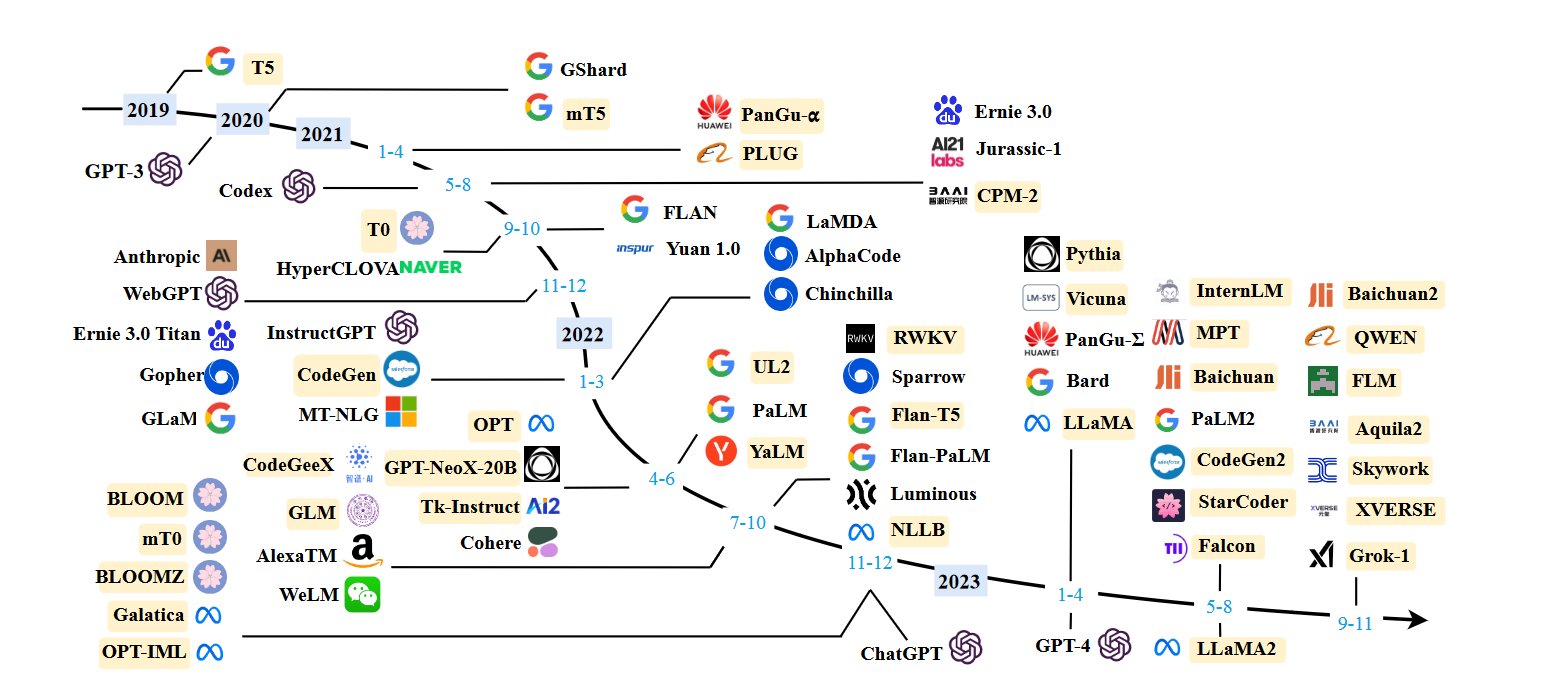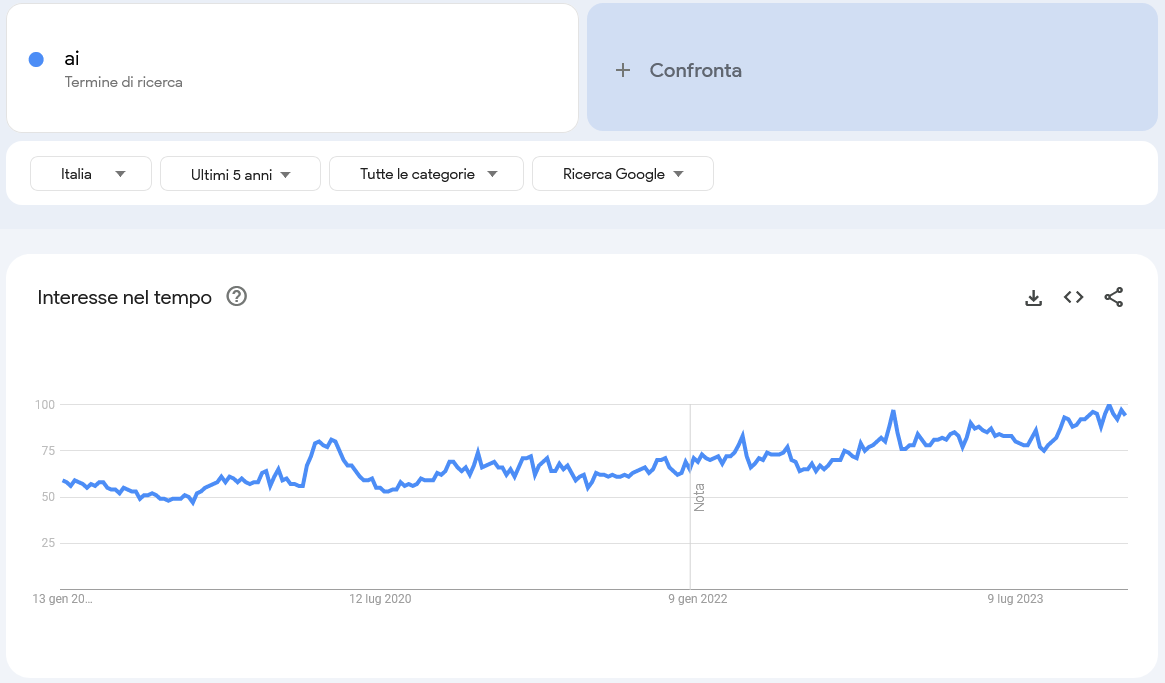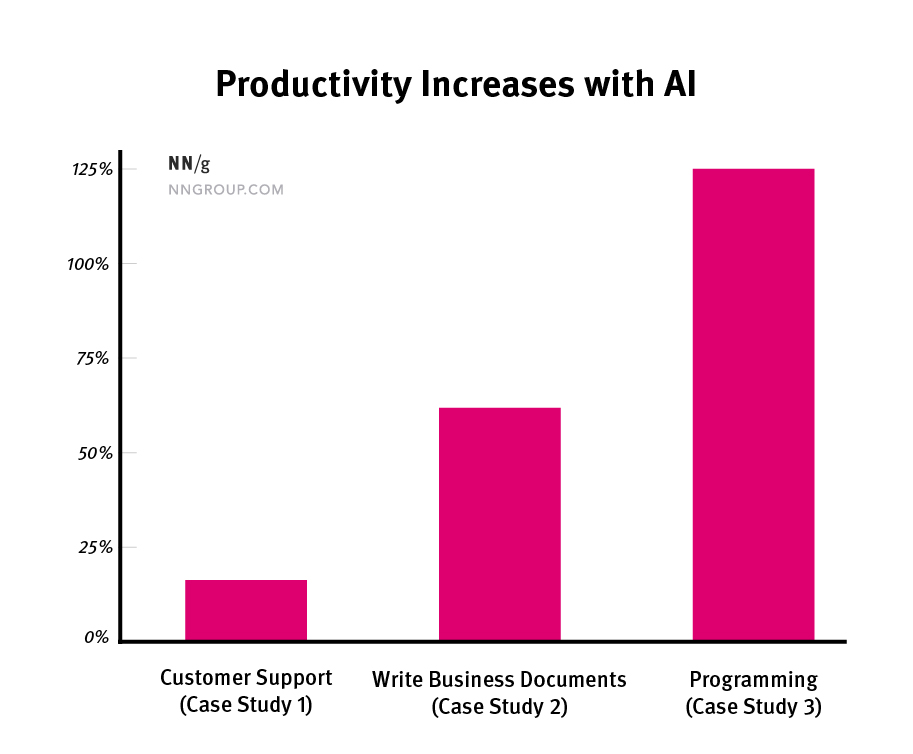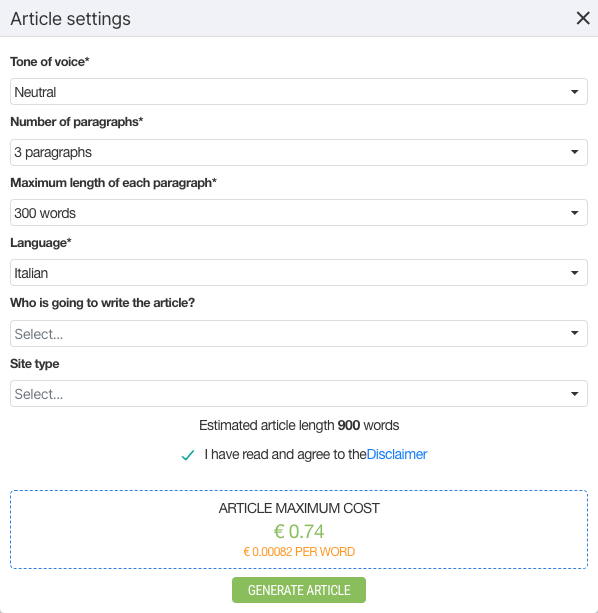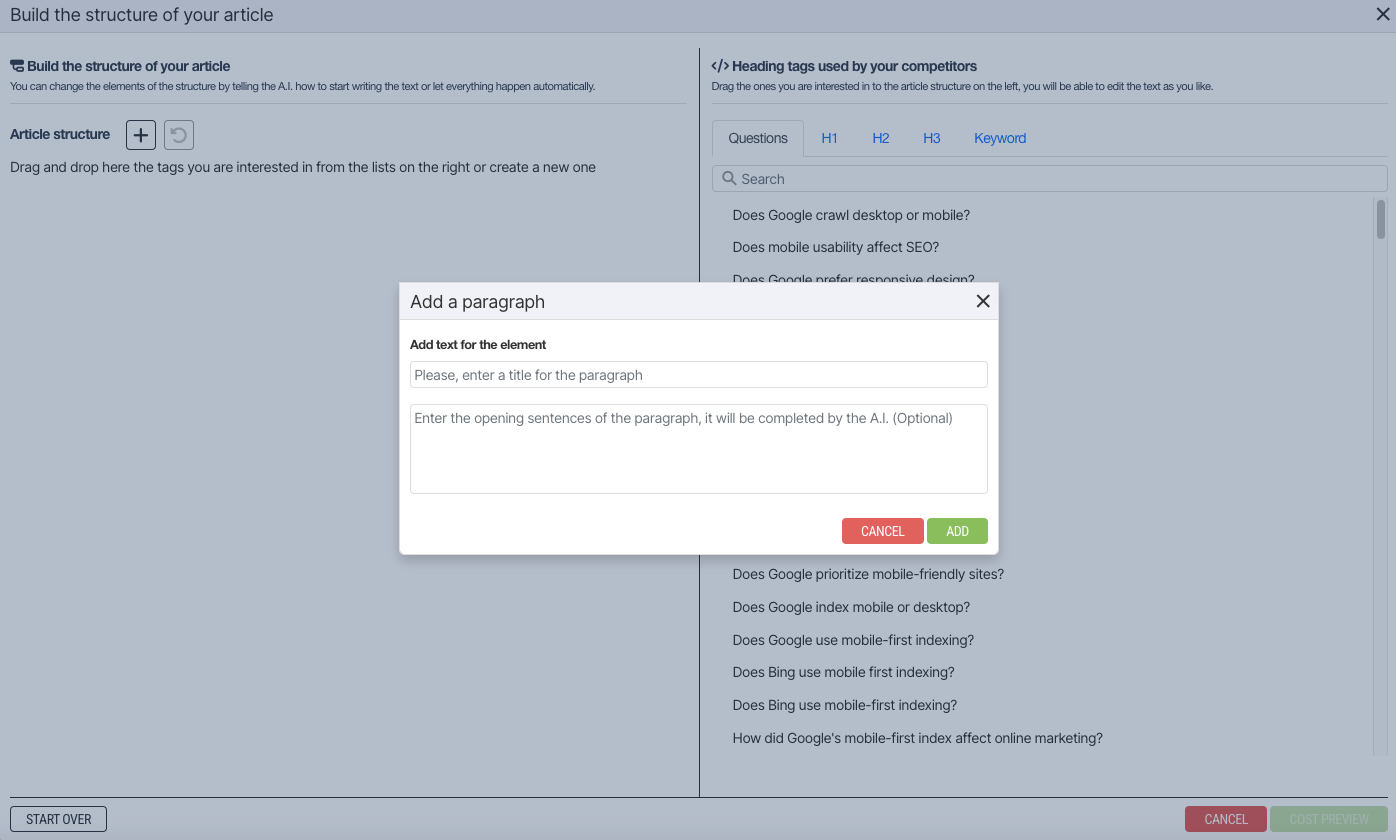How to use AI to write SEO texts: a balanced approach
In the past year, artificial intelligence has gone from being something extremely futuristic to a present, everyday reality. In just a few months we have seen this technology transform (or threaten to transform) manufacturing, customer service and financial sectors, and its applications have not “spared” digital marketing and SEO either. In particular, content generation via artificial intelligence is the topic of the moment, and AI content generators aim to make content marketing more efficient and cost-effective: of course, “all that glitters is not gold,” but we will see how it is possible to integrate new technologies with the author’s experience and skills and be able to write SEO-performing texts more effectively and quickly.
What is Generative Artificial Intelligence and what are its applications
As Ralph Waldo Emerson says, “Knowledge is the antidote to fear,” and so let us first understand what we refer to by AI and what Generative Artificial Intelligence is.
Artificial intelligence (often rendered in the acronym AI) is a branch of computer science concerned with creating systems that can perform tasks that would normally require human intelligence. Using advanced algorithms, software and systems, this technology can mimic human cognitive functions, such as learning, understanding natural language, reasoning, adapting and solving complex problems.
Artificial Intelligence has quickly become one of the most discussed and studied technologies of recent years-it was not “born” in 2022 or today, but has been talked about for a very long time, as also seen in this image. As computational capabilities increase and large amounts of data become available, AI algorithms are becoming increasingly sophisticated and capable of solving complex problems autonomously.
Then there is generative artificial intelligence, which is a subset of AI that uses techniques such as neural networks to make outputs that seem realistic and plausible to human observers: from the data provided or learned, it is able precisely to generate something that did not exist before. To be more precise, thanks to machine learning it can process a huge amount of visual or textual data, largely collected from the Internet, and determine which things are most likely to appear next to others: in this way it responds to the instructions (prompts) it receives, providing output that falls within the range of probability determined by the corpus of which it is composed – words and phrases in the case of chatbots such as ChatGPT, or visual elements for DALL-E or Midjourney.
And it is precisely the latter technology that is before our eyes (almost literally), particularly since precisely OpenAI released ChatGPT, a language model based on generative AI that uses automated processes to produce, manipulate and synthesize data in textual form. The great novelty of ChatGPT lies in the fact that it has succeeded from the start in producing coherent texts by imitating human language, proving extremely useful for applications in the field of communication and content marketing.
In recent months, AI has been gaining ground in digital conversations (and beyond, as the research trend shows) but especially in numerous professional fields, imposing itself as a tool to increase efficiency, innovation and personalization of services through the creation of realistic content in various fields, with innovative implications but also ethical uncertainties.
Learning about and using generative artificial intelligence
Let’s focus specifically on generative artificial intelligence, which can have multiple applications and implications, both in terms of innovation and ethical challenges, such as the spread of deepfakes or the creation of fake or misleading content-or, even more trivially, very low-quality text with which to populate sites, which Google has also already spoken out against.
Let’s clear the field of doubts right away: there are indeed several critical issues related to the very nature of AI-based systems, which include, for example, privacy invasiveness, potential increase in unemployment over the medium to long term, and questionable use on the ethical front of data management; in addition, and in a broader sense, AI-based systems can affect society in significant ways, manifesting issues such as discrimination, centralization of power, and potential for social control.
These issues and concerns call for resolutions at a much higher level – and indeed various policy committees and specialized groups are at work to find appropriate solutions (or at least reassuring answers) to the problems – but we try to focus on the more practical and “mundane” aspects of AI.
Basically, generative AI algorithms, such as OpenAI’s ChatGPT-4, can produce coherent and well-structured texts on a wide range of topics, mimicking human style and language. This is why they have become a frequently used solution in the context of digital marketing, for example, to create fully automated sites, write texts in seconds, set up chatbots or automatic responses to emails and other communication tools.
The strength of the system lies precisely in its speed, convenience and (at least “perceived”) efficiency: ChatGPT offers answers in no time, has no requirements, helps organize thinking or create new content from scratch, plus scores high on IQ simulations. For example, Eka Roivainen administered a partial intelligence test to ChatGPT, estimating its Verbal IQ with a value of 155, while David Rozado used a Verbal-Linguistic IQ Test that returned a value of 152: in both cases, this is higher than 99.9 percent of test takers. However, it is worth specifying that, as an artificial intelligence, ChatGPT does not have an IQ in the human sense of the term because it has no consciousness, emotions or autonomous understanding, and therefore these studies are precisely simulations and approximations, which nevertheless tell something about this technology.
In concrete terms, a study by the Nielsen Norman Group reveals that using generative artificial intelligence (such as ChatGPT) in business applications improves user performance by 66 percent, averaged over 3 case studies; benefiting the most are the most complex tasks and the least skilled workers, with the programming domain potentially benefiting from a 126 percent increase in coding projects per week compared to those performed by human staff alone.
The limits of AI: not just hallucinations
As fairy tales teach, all that glitters is not gold, and at present, it is not possible to fully rely on ChatGPT or AI without human control at least at the review stage (or, at least, it is not possible if we aspire to sustained success and have a quality-based project in mind), and this depends on the very nature of this technology.
As we said, ChatGPT and related are artificial intelligence-based language models capable of generating text based on what is given to them as input: that is, they are “neutral” tools, which have no real understanding of the meaning or veracity of the text they produce, but try (with increasing success) to mimic the style and content of what they have learned from a vast amount of data from the Internet.
As a result, ChatGPT can sometimes “hallucinate” and invent false or nonexistent information, especially when we ask them to write about specific or complex topics, such as law or health (which is why there are so many disclaimers and blocks on the subject).
In general, we can highlight at least 10 major limitations of Generative Artificial Intelligence that, as we said, should push us to a more reasoned use of the tool.
- This is certainly the most frequent (and complicated to unearth) case: AI can generate information that, although it may seem plausible at first glance, has no correspondence with reality. The phenomenon known as “hallucination” can be particularly problematic in contexts where data accuracy is crucial, such as in journalism or financial analysis, and only proper text checking (genuine fact-checking) can expose erroneous passages.
- Outdated information. Using outdated datasets can lead AI to provide recommendations or analysis that no longer reflect the current situation, and this can have negative consequences in dynamic areas such as marketing or cybersecurity.
- AI can produce content that lacks coherence and cohesion, resulting in fragmented and repetitive content.
- AI may have difficulty capturing all the nuances and specific context of a situation, especially in complex or ambiguous scenarios.
- Tonality. Finding the right tone is essential to communicating effectively, but AI may have difficulty capturing the user’s desired style or tone.
- Originality. While AI can certainly generate content on a large scale, it finds it more difficult to produce truly new and unique ideas (and in fact, it is not terribly difficult to detect fully AI-generated text).
- AI can introduce bias into its outputs if the training data contain bias, causing the reiteration of discrimination or unfair decisions.
- Sensitivity. AI can generate offensive or inappropriate content if it is not properly supervised or if the training data contain problematic examples.
- Verifiability. Validation of AI-generated information can be less smooth, especially when complex or niche data are involved.
- Over-reliance on AI can lead to neglect of critical human intervention and professional judgment.
Some of these limitations are surmountable and will be overcome by continued work on the tool-for example, by expanding and refining training, including with ethical and diverse practices to reduce bias in AI models-but fundamentally there is a lesson to keep in mind that “invests” each of us who use AI: the quality of the answer depends on the intelligence of the question.
Often, in fact, the error lies in the prompt, and misinterpretation of those initial instructions can lead AI to generate irrelevant or misleading outputs.
Neither apocalyptic nor integrated: adding AI to the SEO copywriter’s tools
Exactly sixty years ago, in 1964, Umberto Eco published “Apocalyptic and Integrated,” in which he analyzed mass culture and its effects on society. In his work, Eco divides intellectuals into two categories: the “apocalyptics,” who see mass culture as the decadence of taste and a danger to high culture, and the “integrated ones,” who accept and find value in popular culture, seeing it as an inevitable and even positive phenomenon.
Today we still oscillate between being apocalyptic or integrated vis-à-vis AI, and not only because of the initials in common. Similar to Echo’s “apocalyptics,” there are those who view AI with suspicion and fear, concerned that it could lead to job losses, erosion of privacy, or even autonomous machine control. These critics warn of the ethical and societal risks that AI could pose, fearing that it could exceed human control and have unintended negative consequences. On the other hand, the “integrated ones” in AI embrace new technologies, recognizing their potential to improve daily life, optimize work processes and solve complex problems. They see AI as a tool that, if used responsibly, can lead to significant advances in fields such as medicine, education and transportation.
In short, there are two poles that see AI as either a miracle solution or a potentially dangerous innovation, but there is an underlying misunderstanding in both cases: that AI is an advanced technology, a tool that supports humans if used well, not a solution to all problems.
This means that a balance needs to be struck between legitimate concerns and acceptance of change, working to mitigate risks while taking advantage of the opportunities presented by these cultural and technological evolutions.
How to use Artificial Intelligence to write text: a balanced approach
In short: willingly or unwillingly, Artificial Intelligence is not only the future, but the present of so many sectors, especially digital ones such as SEO, and is therefore a de facto reality with which we must deal, possibly without fear or excessive enthusiasm.
Returning to our area of discussion, in particular, artificial intelligence should not frighten SEO copywriters, as long as they take a responsible and balanced approach to guiding and harnessing it to simplify the work of writing and produce content more effectively and quickly suited to today’s web.
That is, a critical approach is essential: we cannot blindly rely on AI to replace our work, but neither can we ignore these technologies or derisk them as a marginal phenomenon.
The starting point is to understand the nature and purpose of the tool, as we have been doing, and to learn how to use it consciously for our needs related to SEO and strategic writing for the web, two fundamental fields in today’s digital communication.
In practical terms, in fact, AI can actually simplify the daily work of copywriters and solve common and frequent problems that occur in the ideation and writing process, provided we handle artificial intelligence text generation features with care (and maybe even help us with SEOZoom, which supports us throughout the editorial creation and development process by providing the fundamental data to increase the chances of success).
AI and SEO copywriting: finding the right path
In recent years, the role of the SEO copywriter has progressively evolved, and the integration of artificial intelligence into the content creation process is the latest challenge in chronological order, which requires us to take a step (including a mental one) in continually exploring and adapting to this technology, but above all in learning how to use the new tools appropriately.
It is therefore first and foremost essential to find the right balance between traditional SEO copywriting skills and the potential offered by AI, which translated into practice means understanding how and for what tasks to use AI to increase the efficiency and quality of our online content, but without replacing the human touch that characterizes persuasive and engaging writing.
Modern SEO copywriting requires a mix of detailed analysis, on-page SEO skills, keyword research skills, and, of course, creativity: to hit our goals, we need to understand users’ needs and know how to respond in a relevant and useful way, anticipating what Google has learned from the countless daily queries.
To write strategically today, we must ask ourselves key questions such as “Who am I writing this content for?”; “How and why will it be useful?”; “How would I search for this information if I were a Google user?” In addition, it is essential that Google recognizes our ability to answer a specific user question and that our text includes the keywords needed to stay focused on the topic, avoiding deviating in directions that could hurt visibility in search results. We also need to analyze competitor content, understand why Google has rewarded their pages, and identify the optimal timing for publishing our content, working well in advance on seasonal or trending topics.
Using tools such as SEOZoom’s Editorial Assistant can help us overcome common writing challenges, allowing us to leverage technology to our advantage.
With the author’s experience and skills, by integrating new technologies, we can create content suitable for the modern web more effectively and quickly. Specifically, we can perform all these tasks accurately and quickly, obtaining reliable data to guide us in creating competitive content, optimized for a wide range of keywords, with real-time suggestions on the keys to tap to increase the chances of ranking well.
Ultimately, a proactive approach to AI-enabled content creation requires a balance between technology and human touch, between data and creative insight, ensuring that each piece of content is informative, relevant and optimized for success.
What we can do with AI applied to content marketing
Content marketing was probably the first field in which we moved from simply “playing with artificial intelligence” to using AI in our day-to-day work, and indeed applications of artificial intelligence to content marketing opens up a world of possibilities for content marketers, allowing them to streamline the content creation process and focus on more strategic and creative aspects.
On a general level, AI can be used at different stages of the content marketing process:
- Generating content ideas. AI can analyze trend data, consumer feedback, and social media discussions to identify topics of interest to target audiences, helping content marketers generate relevant and engaging content ideas that address user needs and questions.
- Create content outlines. Once a topic has been identified, AI can help structure the outline of a piece of content, organizing headlines, subheadings, and key sections, so that you have a solid foundation on which to build the article, with the assurance that all important aspects are covered.
- Writing first drafts. Using advanced language models, AI can produce drafts of content that serve as a starting point for authors. These drafts can include introductory paragraphs, food for thought, and conclusions, which the author can then expand and customize by adding his or her personal “twist.”
- Rapid content search. AI can speed up the search for information by quickly analyzing a wide range of sources to gather data, statistics and citations that enrich the content and increase its credibility.
- Perform keyword research and clustering. AI can perform in-depth keyword research, identifying terms and phrases relevant to the topic at hand, though obviously with less precision and data than specific SEO tools. It can also group keywords into thematic clusters, helping to create content that is optimized for search engines and answers several related queries.
- Simplify the creative review workflow. AI can simplify the review process by providing suggestions on style, tone and consistency, freeing up time and attention for high-level improvements rather than basic errors.
- Edit and proofread. AI tools can help correct grammatical, spelling, and syntax errors, as well as suggest stylistic improvements.
- Check for plagiarism and AI content: AI can scan content to ensure that it is original and not plagiarized-again, with efficiency not always matched by specific anti-plagiarism software; some tools can also detect whether a text was generated by another AI, ensuring the authenticity and uniqueness of the content.
Without necessarily being “integrated” or “enthusiastic,” it is therefore clear that being able to incorporate AI into the content marketing workflow can improve efficiency and productivity, provided as mentioned that we maintain a balance between the use of technology and human intervention, that is, ensuring that creativity and personal experience remain at the center of our strategies.
Integrating new AI technologies with Author Experience and Expertise is a process that requires a deep understanding of both the potential of AI and the unique skills that only a human author can offer. This means using AI as a tool to amplify and enhance human work, rather than as a substitute.
Thus, it is true as mentioned above that AI can be employed to automate keyword research, provide suggestions on trending topics, create editorial plans, and even generate drafts of content that the author can then refine and customize – and this allows authors to focus on more creative and strategic aspects of writing, such as developing narrative voice, deepening subject matter, and tailoring content to target audiences.
But, even in light of Google’s EEAT (Experience, Expertise, Authoritativeness, Trustworthiness) paradigm, we cannot “forget” the importance of experience, expertise and trustworthiness in online content: AI can help identify content that meets these criteria, but ultimately it is human experience that ensures that content is truly authoritative and trustworthy.
Artificial Intelligence can therefore lead the way, help us solve routine and “boring” tasks, relieve us of the burden of doing tons of research to find sources and information, but it cannot (yet?) fully replace a human author, who remains the guarantor on the quality and readability of the content. In this sense, integrating AI technologies with the author’s experience and skills is essential to create content that is not only optimized for search engines, but is also of high quality, informative and reliable, useful, and able to answer people’s questions with authority and depth.
How to use artificial intelligence to write text: a guide to SEOZoom tools
What we have just described is the approach we have had from day one at SEOZoom, which as early as December 2022 added a number of Artificial Intelligence tools for content generation, while clearly specifying that these features were always to be used in a conscious and “guided” manner, both for practical and ethical issues.
Specifically, we developed a special section of AI Tools designed to make the task of copywriters and all those engaged in online text writing easier and faster: these are about thirty micro-tools that perform a single action and solve a specific problem. For example, those involved in e-commerce sites can find great benefit from using the tools to create a product sheet, generate a compelling and persuasive headline for the product page, or even write entire category texts. Also very straightforward are the tools for SEO, which allow, among other things, finding relevant keywords with respect to the topic of interest, generating title and description or discovering user needs, and those for copywriting in a broader sense, which allow reworking an already written text to make it more centered and more useful, writing introductory paragraphs on any topic, finding ideas for content, suggesting sentences from scratch or completing periods that have “stuck” us, and so on.
Compared with the use of classic AI-powered text generation tools, the great advantage lies in being able to take advantage of ready-to-use prompts that are optimized to provide the desired result by entering only the information needed to guide the tool.
For those who want a complete text, then, the reference tool is the AI writer present within the Editorial Assistant, which combines all the advantages and convenience of Artificial Intelligence with the information and effectiveness of SEOZoom to automatically create texts optimized according to SEO best practices thanks to our software data.
With the AI Writer SEOZoom redefines content marketing by combining artificial intelligence with its deep SEO analytics capability: in seconds we can generate useful, interesting, original, and quality content for any type of site, thanks to a tool that writes like a copywriter and thinks like an SEO specialist, combining creativity and data to generate texts that win audiences and appeal to search engines.
Our AI technology is honed to understand and adapt to Google’s criteria, ensuring that every article, post or product description is a step closer to site success – which is why, with a hint of conceit, we call it “the best AI content generator for SEO.”
How SEOZoom’s AI writer works
SEOZoom is therefore the only SEO software that allows its users to use the power of the most powerful AI systems to support the creation of text optimized according to SEO best practices: in practice, we have at our disposal an article generation function via Artificial Intelligence, capable of producing text similar to natural human language, with the added value provided by the suite’s data, which allows the content to be directed toward satisfying users’ search intent.
This feature has a pay-as-you-go cost mechanism, and each text generation has a variable price based on the amount of paragraphs set and the expected number of words.
Thanks to AI Writer, we can structure and provide an SEO-oriented canvas for artificial intelligence to launch text generation through an SEO analysis done in real time on the content of competitors already positioned in SERPs, so as to obtain a text that contains the topics and keywords that Google – and users – consider a priority in relation to the topic we are going to write about.
Content creation begins with setting the target keyword and any secondary keywords we deem necessary to give depth to the article, and then choosing whether to completely entrust the generation to Artificial Intelligence or manually determine the paragraphs of the text.
In the first case, we will only have to set the variables that personalize the content and make it fit our needs, while in the other situation we can personally intervene to guide the AI in organizing the structure of the text, either by dragging the tags we are interested in from the lists on the right or by creating a new one.
In the latter case, we can then decide how to build the skeleton of the article, taking cues from the headings already used by competitors or from the frequently asked questions that users ask on the web about the chosen topic, which will become the paragraphs of the new content; in addition, we can also start writing the text ourselves, asking the AI to complete the work, or let everything happen automatically.
In both cases, however, we can then target the writing to the type of site and style closest to our “standards” and desires through a simple menu, which basically acts as a filter to customize the prompt. Among the variable settings are the choice of the tone of voice most appropriate to the topic, the number of words for each paragraph, the identification of the professional “figure” writing the content and the type of site, which serve precisely to refine the instructions to be given to the Artificial Intelligence in order to obtain a text as useful as possible and close to what we actually need.
The system is so advanced that it avoids the risk of “duplication”: in fact, even when entering the same keywords and topics, the AI always manages to provide different texts, while still respecting the input settings.
The automatic text generation tool and, more generally, SEOZoom’s AI tools are therefore of exceptional practical value, because they allow us to create already SEO-oriented articles in very little time and on any topic, proving to be a valuable support for finding insights on topics that we do not know or master perfectly, or for starting a work to which we then add the “human factor” that, we reiterate, we continue to consider indispensable.


